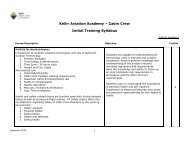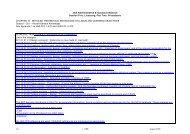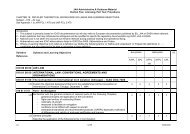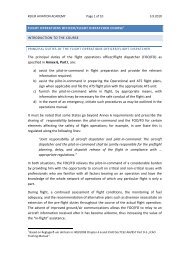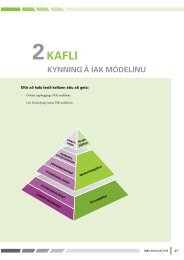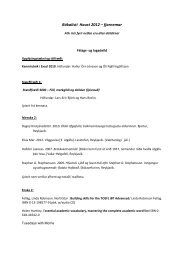RNAV Training Manual - Keilir
RNAV Training Manual - Keilir
RNAV Training Manual - Keilir
Create successful ePaper yourself
Turn your PDF publications into a flip-book with our unique Google optimized e-Paper software.
How does GPS work?<br />
7. The GPS Receiver: Calculation of time and position<br />
Stage 1: The pseudorange Stage 2: The accurate fix<br />
Wh When th the GPS receiver i is i started-up, t t d it its iinternal t l or llocal l clock l k will ill be b Th The Receiver R i th then uses th the ephemeris h i (orbital) ( bit l) ddata t iin each h<br />
inaccurate by an unknown error, called clock bias or offset, compared to<br />
the reference GPS Time<br />
A modern quartz clock may be accurate to one part in a million (ie. drift by one<br />
microsecond every second). This means that after only 1s, the internal clock error can be<br />
th the equivalent i l t of f hundreds h d d of f metres t (1 (1µs = ~300m 300 at t th the speed d of f li light). ht) A unit it th that t s<br />
been switched off for a week or two could be inaccurate by ~1s or hundreds of thousands<br />
of km.<br />
The first stage of the navigation problem is to calculate pseudoranges<br />
from the visible satellites to the GPS, ignoring the local clock offset.<br />
Th These ranges are pseudo d because b they th are all ll kknown tto bbe wrong by b<br />
the same (unknown) local clock error<br />
For any given satellite, the Receiver generates the satellite s PRN code<br />
internally, based on its code book , and starts the code sequence at the<br />
time t e its ts local oca cclock oc says the t e sate satellite te sshould ou d have a e sta started ted its ts PRN<br />
transmission. The internal PRN code is then time-shifted until it matches<br />
(locks-on) to the PRN code signal from the satellite. This time-shift, or<br />
offset, is the (pseudo) elapsed time between transmission and the<br />
reception Time of Arrival (TOA)<br />
Th The Pseudorange P d iis dderived i d ffrom the th TOA, TOA assuming i a given i speed d ffor<br />
radio wave travel and the decoded time of transmission from the satellite<br />
The 1023 bit PRN code is transmitted at 1000 times per second, and the Receiver can<br />
judge the start of a bit to about 1%, so the maximum accuracy of the C/A code is ~3m<br />
By y decoding g the Navigation g Message, g , the Receiver gets g data that allows it to correct<br />
Pseudorange for the following errors<br />
The SV (Satellite Vehicle) time offset from GPS time<br />
Basic ionospheric corrections from the Almanac<br />
Relativistic effects and receiver noise<br />
The Receiver calculates pseudoranges from different satellites<br />
simultaneously, so they are all subject an identical local clock error<br />
satellite s Navigation Message to establish the satellite s position in<br />
space at the time of the Pseudorange calculation<br />
It requires a minimum of 4 satellite pseudoranges to determine a 3D<br />
navigational a gat o a fix for o tthe e Receiver. ece e<br />
The GPS system specification is that 5 satellites should always be available above<br />
a mask (elevation) angle of 7.5 degrees (usually it is 6 or more)<br />
With 4 satellite positions known and 4 pseudo ranges calculated,<br />
the navigation problem can be expressed as 4 equations with 4<br />
unknowns ( (the unknowns being the x,y,z position of f the receiver<br />
and t, the clock bias error)<br />
The Receiver calculates a solution to these equations and<br />
establishes a position fix<br />
With true t (rather ( th than th pseudo) d ) ranges, it would ld only l require i 3 satellite t llit position iti<br />
spheres to determine a fix intersect. However, with pseudoranges, a 3 sphere<br />
solution would give the wrong range. 4 pseudoranges spheres won t intersect at a<br />
point because the ranges are not true and consistent with a single point in space.<br />
The receiver, in effect, solves the equations to determine which value of local clock<br />
error creates the best intersect of the 4 spheres<br />
The receiver also calculates a Geometric Dilution of Precision (GDOP), based on<br />
the relative position of the satellites (satellites close together provide a weaker fix)<br />
When more than 4 satellites are available, modern receivers use<br />
various other algorithms to provide a better fix<br />
Fi Finally, ll th the x,y,z position iti ffrom th the centre t of f th the earth th iis translated t l t d<br />
into latitude, longitude and altitude using the WGS84 datum, and<br />
GPS Time is converted into UTC. (See later pages on WGS84)<br />
Velocity (ie. ground speed and ground track) is calculated using a<br />
combination of rate of change of position and Doppler shift<br />
measurement of the L1 carrier frequency of different satellites,<br />
compared to the receiver s L1 oscillator frequency<br />
P A<br />
46



